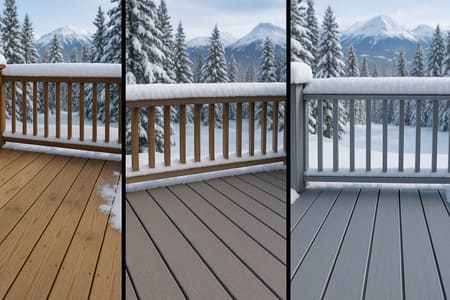Best Deck Materials for Montana Snow Loads: Treated, Composite, or Metal Framing?

Building a deck in Kalispell means planning for some of the harshest snow loads in the country. Long winters, heavy drifts, and freeze-thaw cycles all take a toll on outdoor structures. Choosing the right materials is more than a design choice-it's the difference between a deck that lasts decades and one that sags or splinters within a few years.
This guide compares three of the top contenders-pressure-treated wood, composite, and metal framing-to help you make the best decision for your property. We'll also look at how spacing, fasteners, and hardware designed for ice and snow can make a major difference in performance.
Pressure-Treated Wood: Classic but Demanding
Treated lumber has been the standard for years thanks to its affordability and availability. For Montana homeowners, it's still a valid option, but there are caveats. Treated wood does provide resistance to rot and insects, but under heavy snow loads it requires closer deck joist spacing. For example, where a mild climate might allow 16-inch spacing, snow load deck joist spacing in Kalispell often requires reducing that to 12 inches to prevent sagging.
Another factor is ongoing maintenance. Snowmelt can penetrate treated wood, freeze, and then expand, causing splits. That means annual sealing is essential. If you love the natural look of cedar or pressure-treated pine, it can work well, but be ready for refinishing and repairs over the years.
Composite Decking: Low Maintenance, High Resilience
Composite materials have become extremely popular, especially in snowy climates. Built from recycled plastics and wood fibers, composites are designed to resist moisture infiltration, so there's no swelling or cracking during freeze-thaw cycles.
Compared to cedar, composite vs cedar in winter is an easy call: composite wins for durability and minimal upkeep. You won't need to sand, stain, or seal every year, and snow removal is simpler since the boards don't splinter. However, composites still rely on a strong subframe. If paired with treated lumber joists, you must account for snow load by using shorter spans and closer spacing. Some homeowners opt for a hybrid-composite surfaces over metal framing-for the strongest balance.
Metal Framing: Strength for the Long Haul
Aluminum and galvanized steel framing systems are gaining traction in areas with extreme snow loads. While the upfront investment is higher, the longevity and load capacity can't be beat. Metal framing resists warping, rotting, and insect damage entirely. Even with heavy drifts and ice buildup, it holds firm without the deflection you'd see in wood joists.
Metal framing also pairs exceptionally well with composite deck boards, creating a virtually maintenance-free deck. Another advantage is lifespan-these systems can last 25 to 50 years with minimal attention. For homeowners planning to build once and enjoy it for decades, metal framing is a compelling option.
Anti-Ice Hardware and Snow-Smart Details
Even the best materials need smart installation to stand up to Montana's winter. Anti-ice hardware such as galvanized brackets, stainless fasteners, and hidden clips rated for cold climates can extend the life of your deck. Choosing railings and posts that shed snow, as well as flashing details that prevent water from entering seams, are also key.
A professional Flathead Valley remodeling contractor will know how to balance spacing, material selection, and hardware so that your structure meets local snow load codes and lasts through years of heavy winters.
Final Thoughts
In Kalispell, building decks isn't just about outdoor living-it's about engineering for one of the most challenging climates in the country. Pressure-treated wood is budget-friendly but requires maintenance and tighter spacing. Composite decking offers durability with less upkeep, while metal framing delivers unmatched strength and lifespan.
For expert guidance and craftsmanship, trust the team that knows Montana's weather best. Contact Lost Creek Construction today to design and build Flathead Valley decks that last through every season.
